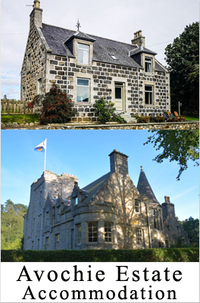Many thanks to Avochie Fishings for facilitating this camera's location and to the The Deveron, Bogie and Isla Rivers Charitable Trust for capitally funding its installation. The Deveron River originates in the hills of West Aberdeenshire, specifically in the remote region known as the Cabrach. It flows in a northerly direction and is joined on its left bank by the Blackwater. From there, it turns northeast as it passes through Strathglass and reaches Huntly. The middle to lower sections of the river offer excellent opportunities for angling, featuring beautiful glides and rocky bottoms that create white water, making it a favorable fishing spot even in low water conditions. The river is susceptible to flash flooding, resulting in its water turning black, but it eventually settles into a golden brown color that fly anglers particularly appreciate.
Salmon can be found anywhere along the river from the opening day on February 11th, although the upper beats are usually preferred by anglers. April and May offer superb brown trout fishing, with many specimens weighing between 5 and 6 pounds caught each year.The sea trout run begins in late May and lasts until July, with 7-pound fish not being uncommon.The grilse run begins in mid-July, but depending on water conditions, it can start as early as June and continue throughout the season.The area around the confluence of the Bogie and Deveron rivers has a long history of settlement, dating back to the Neolithic period. Archaeological excavations have revealed remains of an Iron Age hillfort on Battlehill, located on the outskirts of the town. During the first millennium CE, the Pictish culture dominated the area. Nearby, in Strathbogie, stood a significant Pictish settlement and vitrified hillfort known as Tap o' Noth. This site held strategic importance as it controlled routes from Moray into Strathdon and Deeside. The first motte-and-bailey castle was constructed on this site around 1180 by Donchaid McDuff, the Gaelic-speaking 2nd Mormaer of Fife. In 1352, the lands were transferred to the Gordon family of Berwickshire as a consequence of McDuff's descendant, David of Strathbogie, defecting from Robert I to Edward I's cause before the Battle of Bannockburn.The settlement at the confluence of the Bogie and Deveron was known as Milton of Strathbogie or The Raws of Strathbogie until 1508. Despite the boggy nature of the surrounding lands at the time, the castle at Strathbogie became a central hub for the Gordons of Moray over the following centuries. The family's power grew through warfare and dynastic marriages, eventually becoming the dominant family in the North-East of Scotland, with the clan chief earning the informal title of Cock o' the North. As a result, a thriving settlement emerged to serve the evolving palace complex. In 1472, the settlement attained the status of a burgh of barony. In 1508, the Gordons received a royal charter that allowed them to rename Milton of Strathbogie and the castle to Huntly, after their ancestral seat in Berwickshire.During the Scottish Reformation, the Gordons played a prominent role as one of the leading Catholic families in the country. They became deeply involved in the conflict between Mary, Queen of Scots, and the reformed church and Protestant magnates. Huntly Castle was besieged and pillaged in 1562 by Mary and again in 1594 by James VI.After the restoration of Gordon titles, the town continued to develop during the 17th and 18th centuries, serving as both a market town and a support center for the Gordons' palace. The town attracted a range of merchants and artisans who catered to the surrounding countryside. In the mid-17th century, there were four separate glovers in the town. The neighboring parishes of Dunbennan and Kinnoir were consolidated into a single parish of Huntly in 1727, although they had long been under the control of the Marquess of Huntly. During this time, the Duke of Gordon initiated the redevelopment of the town as a planned town with grid-iron streets.In the 18th century, the flax industry and related cottage industries such as heckling, spinning, bleaching, and weaving experienced significant development in the area. However, the trade was hindered in the long term by inadequate transportation infrastructure to Banff and Aberdeen. Smuggling whisky also played a significant role in the local trade until the industry became licensed in 1823.In the 19th century, following a decline in the linen trade after the Napoleonic era, the town underwent another period of growth. The establishment of rail transport in 1845, coupled with a shift from peasant farming to capitalist agriculture, contributed to this growth. Huntly became an important market and shipping center, while the surrounding parishes experienced depopulation.In 1836, the town and the Gordon estates passed to the Sussex-based 5th Dukeof Richmond through inheritance. The ownership of feu, land, and property remained with the Dukes of Richmond and Gordon until August 1936 when all the property and feus in the town, along with much surrounding farmland, were sold at an auction held at Huntly Town Hall. The proceeds from the auction were used to pay off death duties on the ducal estates.
Although the population of the town has fluctuated slightly throughout the 20th century, with a net outward migration after World War II, the population in 2018 stood at 4,650, compared to 4,229 in 1911. The most significant demographic growth occurred during the 19th century, with the population increasing from 1,000 in 1800 to 3,600 in 1861.







